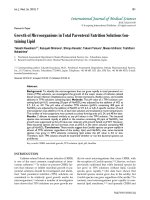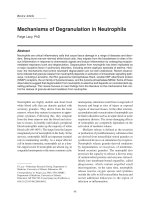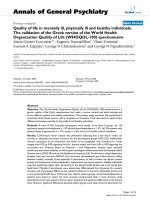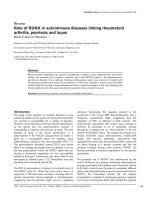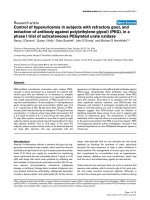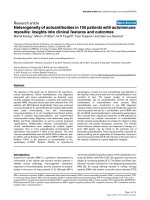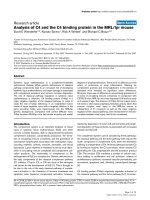Báo cáo y học: "Dose of dialysis in the intensive care unit: is the venom in the dose or in the clinical experience" pdf
Bạn đang xem bản rút gọn của tài liệu. Xem và tải ngay bản đầy đủ của tài liệu tại đây (43.52 KB, 2 trang )
Available online />Page 1 of 2
(page number not for citation purposes)
Abstract
Many studies on the most ‘adequate’ dose of renal replacement
therapy (RRT) in critically ill patients with acute kidney injury have
obtained contradictory results. The previous issue of Critical Care
reports a multi-centre study showing that a higher than conven-
tional dose of RRT, whether continuous RRT or intermittent RRT, is
not associated with better survival of these patients. This commen-
tary highlights some of the problems associated with the interpre-
tation of this and previously published studies. These problems
include the use of targets of Kt/V urea or the ultrafiltration rate in
millilitres per kilogram body weight, the latter quite difficult to
estimate in these patients, the divergent co-morbidities of the
patients, and the local experience of intensivists or nephrologists with
either continuous RRT or intermittent RRT. The last factor could explain
why some single centre studies did find an impact of dialysis dose on
the survival of these patients whereas multi-centre studies did not.
In the previous issue of Critical Care, an article by Vesconi
and colleagues [1] describes the impact of the dose of renal
replacement therapy (RRT) on clinical outcomes in critically ill
patients with acute kidney injury. This study was performed in
a number of European intensive care units (ICUs). Dialysis
dose was defined as more intensive (continuous RRT (CRRT),
>35 ml/kg/h; intermittent RRT (IRRT), >6 sessions/week) or
less intensive (CRRT, <35 ml/kg/h; IRRT, <6 sessions/week).
The study did not provide evidence for a survival benefit of a
higher dose of RRT. However, more intensive RRT was
associated with a favourable effect on ICU stay and duration
of mechanical ventilation among the surviving patients.
Studies of this nature are not easy to perform and the authors
are to be commended for their initiative.
This paper highlights many of the controversial aspects of
RRT management in these patients, including when to start,
which modality is preferable, and what dose to apply. These
controversies are partly fuelled by a lack of consistent data,
which are difficult to obtain in this heterogeneous patient
group, with wide ranges of applied practices and underlying
diseases and the absence of universally accepted definitions.
For example, analysis of Table 1 in the paper by Vesconi and
colleagues [1] reveals the wide diversity of the patient study
population involved; the distribution of the RIFLE classifica-
tion at the start of RRT is intriguing as a substantial portion of
the patients was started on dialysis without even having class
‘I’ of RIFLE. Besides the fact that the RIFLE criteria are not
intended to be a guide as to when to start RRT, this means
that some of these patients had near ‘normal’ serum
creatinine levels at the beginning of RRT. The question can
be raised as to whether the inclusion of such patients
influenced the outcome, although it is unclear how and to
what extent this might be the case.
Another question to be considered is how the results of this
study should be interpreted in the context of other dose of
dialysis/outcome randomized trials using CRRT (continuous
haemofiltration or haemodiafiltration), IRRT - including the
conventional 3 to 4 hour sessions or the prolonged slow
extended dialysis (SLED) method - or both. Obviously, such
studies produced mixed results. Some showed a benefit of
the ‘higher than usual doses’ [2-4], but others did not [5-8].
All these studies were accompanied by a number of critical
reviews and editorial comments [9-12]. Although none of the
studies showing no benefit of higher dose of RRT were
perfect, all have one advantage: they reflect daily practice.
This is also the conclusion of the paper by Vesconi and
colleagues. Does this mean that dialysis dose is not
important? Probably not. The problem is that we have no
correct understanding of what ‘dose’ means and higher
doses implicitly mean more complications and/or comor-
bidities.
Commentary
Dose of dialysis in the intensive care unit: is the venom in the
dose or in the clinical experience?
Norbert Lameire, Wim Van Biesen and Raymond Vanholder
Renal Division, University Hospital, De Pintelaan 185, 9000 Gent, Belgium
Corresponding author: Norbert Lameire,
Published: 10 June 2009 Critical Care 2009, 13:155 (doi:10.1186/cc7873)
This article is online at />© 2009 BioMed Central Ltd
See related research by Vesconi et al., />CRRT = continuous RRT; ICU = intensive care unit; IRRT = intermittent RRT; RRT = renal replacement therapy.
Critical Care Vol 13 No 3 Lameire et al.
Page 2 of 2
(page number not for citation purposes)
In the study by Vesconi and colleagues, differences in dose
for CRRT were not pursued intentionally but seem to have
been the consequence of external conditions, of which body
weight of the patients was the main one. The patients with
the lowest dose of CRRT were approximately 33% heavier
than those with the highest dose. This is, of course, an
important and remarkable confounder. In interventional studies
where dialysis dose is normalized to body weight, other
difficulties may arise as well. What should be considered as
‘body weight’: dry weight, weight before admission, real ad
hoc weight, distribution volume of urea, or something else?
And how do we estimate this sometimes quite fluctuating
‘body weight’ in a critically ill patient? In the IRRT group, the
dose was expressed as the number of dialysis days per week,
targeting a Kt/V urea threshold. However, as long as we
know neither the nature nor the kinetics of many of the ‘toxins’
involved in the acute ‘uraemic syndrome’ we will always have
to rely on surrogate markers, of which the volume status of
the patient - which should be frequently clinically evaluated -
and electrolyte and acid-base disturbances - which should be
managed - are probably the most important. As such, the fact
that absolute ultrafiltered volumes were comparable in both
the less and more intensive patient groups makes it
questionable whether there really was a difference of dose in
the study by Vesconi and colleagues. Interestingly, there was
also no difference in obtained net ultrafiltration between low
and intensive dose groups in the VA/NIH trial [7] and a study
by Tolwani and colleagues [8]. So, maybe our ‘concept’ of
what dose actually means in ICU patients needs to be
redefined.
Another problem of ‘dose’ is that it comes at a price. The high
dose group in the VA/NIH study [7] suffered a substantially
higher number of complications, such as haemodynamic
instability and electrolyte disturbances. The potential benefit
of achieving more clearance can thus be eliminated by a
higher complication rate. Complication rates might, in turn, be
corrected by centre experience; this could explain why the
first, but single centre, study of Ronco and colleagues [2]
found that dialysis dose did have an impact whereas the
multicentre VA/NIH study [7] did not. As the latter study
enrolled approximately 500 patients in 30 centres, it can be
presumed that a substantial number of the study centres
recruited less than 10 patients per year. The ‘dose of
experience’ with RRT in the ICU might be a greater
determining factor of outcome in critically ill acute kidney
injury patients than the dose of dialysis.
Finally, despite the previous seminal study [2] by the senior
author of the paper by Vesconi and colleagues demonstrating
that a ‘high’ dose of 35 ml/kg/h CRRT is advantageous, the
latter study shows that, in daily clinical practice, this dose is
quite difficult to achieve. It should be appreciated by readers
that the same advocates of a high dose of RRT are now
amending their previous recommendations.
Competing interests
The authors declare that they have no competing interests.
References
1. Vesconi S, Cruz DN, Fumagalli R, Kindgen-Milles D, Monti G,
Marinho A, Mariano F, Formica M, Marchesi M, René R, Livigni S,
Ronco C for the DOse REsponse Multicentre International collab-
orative Initiative (DO-RE-MI Study Group): Delivered dose of
renal replacement therapy and mortality in critically ill patients
with acute kidney injury. Crit Care 2009, 13:R57.
2. Ronco C, Bellomo R, Homel P, Brendolan A, Dan M, Piccinni P,
La Greca G: Effects of different doses in continuous veno-
venous haemofiltration on outcomes of acute renal failure: a
prospective randomised trial. Lancet 2000, 356:26-30.
3. Saudan P, Niederberger M, De Seigneux S, Romand J, Pugin J,
Perneger T, Martin PY: Adding a dialysis dose to continuous
hemofiltration increases survival in patients with acute renal
failure. Kidney Int 2006, 70:1312-1317.
4. Schiffl H, Lang SM, Fischer R: Daily hemodialysis and the
outcome of acute renal failure. N Engl J Med 2002, 346:305-
310.
5. Bouman CS, Oudemans-van Straaten HM, Tijssen JG, Zandstra
DF, Kesecioglu J. Effects of early high-volume continuous ven-
ovenous hemofiltration on survival and recovery of renal func-
tion in intensive care patients with acute renal failure: a
prospective, randomized trial. Crit Care Med 2002, 30:2205-
2211.
6. Faulhaber-Walter R, Hafer C, Jahr N, Vahlbruch J, Hoy L, Haller H,
Fliser D, Kielstein JT: The Hannover Dialysis Outcome Study:
comparison of standard versus intensified extended dialysis
for patients with acute kidney injury in the intensive care unit.
Nephrol Dial Transplant 2009, [Epub ahead of print].
7. VA/NIH Acute Renal Failure Trial Network, Palevsky PM, Zhang
JH, O’Connor TZ, Chertow GM, Crowley ST, Choudhury D, Finkel
K, Kellum JA, Paganini E, Schein RM, Smith MW, Swanson KM,
Thompson BT, Vijayan A, Watnick S, Star RA, Peduzzi P: Inten-
sity of renal support in critically ill patients with acute kidney
injury. N Engl J Med 2008, 359:7-20.
8. Tolwani AJ, Campbell RC, Stofan BS, Lai KR, Oster RA, Wille
KM: Standard versus high-dose CVVHDF for ICU-related
acute renal failure. J Am Soc Nephrol 2008, 19:1233-1238.
9. Bonventre JV: Dialysis in acute kidney injury - more is not
better. N Engl J Med 2008, 359:82-84.
10. Humes HD, Ding F, Song JH: Dialysis dosing in critically ill
patients with acute kidney injury. Am J Kidney Dis 2008, 52:
649-652.
11. Lameire N, Van Biesen W, Vanholder R. Acute kidney injury.
Lancet 2008, 372:1863-1865.
12. Ronco C, Cruz D, van Straaten HO, Honore P, House A, Bin D,
Gibney N: Dialysis dose in acute kidney injury: no time for
therapeutic nihilism - a critical appraisal of the Acute Renal
Failure Trial Network study. Crit Care 2008, 12:308.


